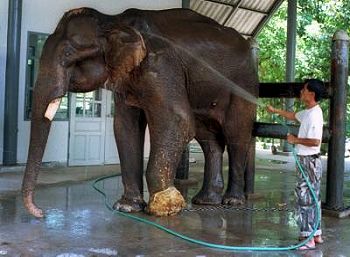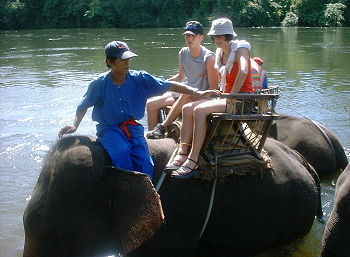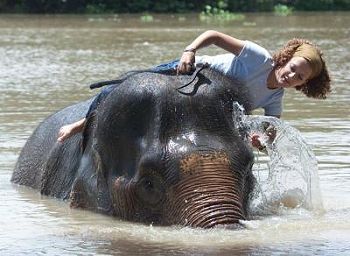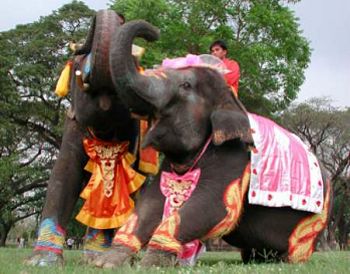Thai Culture - Elephants Adapted from: Thai Street Food in my Area by Gor (Panrit "Gor" Daoruang) a Thai Teenager and his webite:
|
|---|
Elephants play an important part in Thai Culture and Lifestyle
The Thai Elephant --Symbol of Nation
Elephants have been revered in Thailand for many centuries. Famous as the strongest beasts of burden, in Thailand they were important in battle, with kings mounted on Elephants fighting the Burmese to defend Thailand on many occasions. They have also been noted for their intelligence, memory and pleasant nature. A Thai legend has it that a marriage is like an elephant-- the husband is the front legs, that choose the direction, the wife the back legs, providing the power !
A white elephant is even included in the flag of the Royal Thai navy, and the "order of the white elephant" is one of the highest honours, bestowed by the king. White elephants, in fact, are very rarely completely white. The skin has to be very pale in certain areas to qualify as a "white elephant"
In the past, wild elephants were caught and trained. The city of Mae Hong Sorn was founded as a stockade for newly caught elephants, since that region had a high elephant population. This century, the number of elephants has declined so rapidly that the entire domesticated stock are one or more generations from their wild forebears. There are still a few thousand wild elephant in northern Thailand, in remote jungle south west of Chiangmai.
The Forestry Department uses trained elephants to extract illegal stores of teak logs, which poachers keep in remote areas where the use of vehicles would be impossible. Most elephants nowadays, however, are used to carry tourists around -- probably easier and more pleasant work than dragging heavy logs !
There are two main species of elephant in the world. The African Elephant -- Loxodonta, which is larger with bigger ears and a less docile nature. The ears help the animal to lose heat on the sunny open country it inhabits in Africa. The Indian elephant -- Elephas, is a native of thick forest, so is smaller, with much smaller ears. There have also been reports of pygmy elephants in South East Asia, only 1.5 metres tall, but these are probably extinct. The Indian elephant is 3 metres from the ground to the highest point of the shoulders (males 50 cm bigger). They weigh about four tons, and need 250 kgs of food a day, and 60 gallons of water.They are vegetarians, eating a wide variety of plants. In Thailand, their favourite food is tamarind, but as anyone who has been to an elephant camp knows, they seem to love bananas and sugar cane. Both sexes have tusks, although they are far larger in the male. Some males do not grow tusks, and are supposed to be better workers.
The trunk is a highly sensitive organ -- capable of very delicate manipulations. I saw an elephant with an itchy leg pull down the branch of a tree to scratch itself. This did not quite do the trick, so it put one end of the branch in its mouth and chewed it a little, then tried again, with better results. This was a clear example of tool making and using -- which used to be a definition of 'human'.
Elephant Society
In the wild, elephants stay together in herds of 5 to 20 individuals. There is always a leader, the strongest male. When threatened, the males, normally docile, will charge their foes. When families give birth, after a gestation period of 22-24 months, she goes to a grassy, comfortable spot with a 'friend', who acts as midwife. This friend clears up the afterbirth and placenta, and keeps mother and baby apart. There are cases of mothers, confused and exhausted, killing their new- born, if there is no friend to stop it. There is nothing sadder than a mother elephant who gives birth to a still born baby. She will stay with the dead body for several days, grieving. The life expectancy of elephants is in the 70's, and many over 100 years have been reported. The usual cause of death in the wild is the teeth, which were out, and the elephant dies of slow starvation.Elephants only sleep for three or four hours a day, usually from 11pm to 3am. They simply lie down, yawning and later snoring just like humans. Only sick elephants sleep standing up.
Training
Elephant calves begin their training when they are about four years old. They quickly learn and obey the words of command. They get to know their driver (mahout), and get used to being mounted and dismounted. For the first month they are kept restrained in a wooden 'crush' while they learn the basics.
Later, they learn more complex instructions needed to work with teak logs, including kneeling, picking things up, dragging, rolling, pushing, carrying etc. By the age of ten, they are ready for 'graduation', and the work of an adult. A working elephant can lift 700kg, and haul two tons of wood one kilometre without a break. Their natural walking speed is about 4km per hour. They reach their physical peak at 25 years old, and work until they are 60 years old, then they are retried and set free.
Where to See and Ride Elephants
There are several sites which have daily elephant shows. The closest is at Mae Sa, only 20 kms from Chiangmai. Further afield is Chiang Dao elephant camp, another 30 kms north. 80kms south of Chiangmai, on the road to Lampang, is the 'Thai Elephant conservation Centre'. Under Royal patronage, opened by Queen Sirikit , a large area of replanted teak forest is worked by donated elephants. The idea is to prove by doing it that elephants make more sense than vehicles -- they do not damage the surrounding forest so much, they do not require petrol, and damage the soil far less than vehicles. There is even a plan to manufacture teak furniture on site in a few years. There is an excellent show tree times a day. At all the camps, after the show those interested can enjoy a ride of various duration's through pretty scenery. There are also several smaller elephant camps, some with shows.
Most elephants in the north are owned by people of the Karen hill tribe -- in fact many of the mahouts wear the traditional red shirts of Karen men.
I once fell off an elephant. Fortunately a very rare event. The beast did not have his usual mahout, and it was very hot. The elephant simply kneeled down, and I and my companion simple slid off. no-one was hurt, but it was quite a shock -- its a long way down!
The Elephant has been a cultural icon of Thailand since ancient days. Inhabiting the lush mountain forests long before the rise of the first civilizations in the land that is now modern-day Thailand, these intelligent pachyderms (as zoologists insist on calling them) were found apt to domestication by man. Their great size and enormous strength were harnessed in many ways, and they became man's ally in labour and warfare. It is doubtful if the abundant teak trees of the northern woodlands could have been exploited so fully without these leviathans to haul the trunks (pardon the pun) to the rivers that were the highways of old. Elephants played their part too in the numerous battles fought between the armies of Thailand and Burma. Towering over the field of combat, fully panoplied and girded for war, they must have been an awesome sight.
But the elephant came to mean much more to the Thai people than a mere beast of burden. It has become a symbol of fortune, and the superstitious will pay to pass beneath the animal's body and receive a share of the luck that it carries. White elephants, through their very scarcity, adopted an importance of their own, and became the rightful property of the reigning monarch. This led to the super imposition of a white elephant on the red field of the national flag of Siam, as Thailand was once known. Early Siamese coins featured an engraved elephant, and their images can be found in abundance in the compounds of many of the older temples.
The Asian elephant, the species found in Thailand, is renowned for its intelligence and is known to actively think about its actions, rather than merely memorise instructions. The creature also has a fine memory and the expression "An elephant never forgets" entered the English language long ago. The term "White elephant", meaning something given that is not wanted, entered western speech many years back, and it is reputed that this originated in old Siam. It was the custom of the monarch to bestow the highest praise by giving a royal white elephant to a courtier as a mark of especial favour, together with a tithe of land to support the animal's needs of grazing and forage. The same gift could also be given by these shrewd rulers to show displeasure, as no land would be provided, and the gift that could not be refused had to be fed at the offender's expense.
Nowadays the elephant is more fully occupied entertaining the multitude of tourists who visit Thailand, but its magnificent image lives on, advertising many modern events or attracting visitors to the numerous shops and factories that cater to their demands. Welcome to Chiangmai and Chiangrai sent their roving reporter to interview some of these descendents of the mighty elephants of old.


Thai man is taking his elephant for a walk into the jungle during a break from logging in the left picture. And in the right picture, the poor elephant has stepped on a landmine near the Burmese border.


Picture on the left is a picture of elephant riding in Kanchanaburi, but there are lots of different places in Thailand. It is very popular for tourists who come to Thailand. And picture on the right, a university student from Utah is a volunteer at the Ayutthaya elephant camp. She has been working there for three months.


An elephant wedding in Ayutthaya province in the left picture and picture on the right is a photo of an elephant crossing the busy expressway in Bangkok. Where I live outside Bangkok I often see elephants walking up and down the road. Car drivers don't like them as they make traffic jams. The lady on the right has a bag of bananas which she sells to people to feed the elephant.
